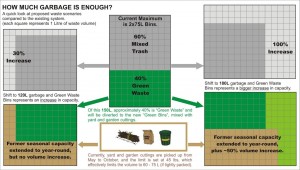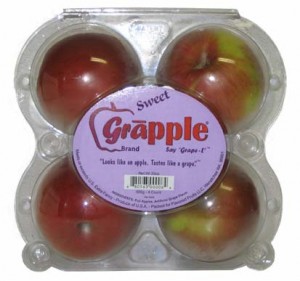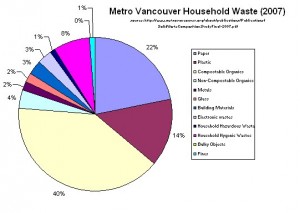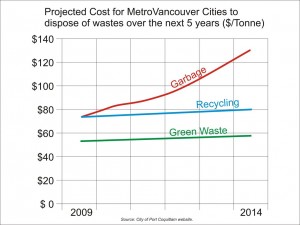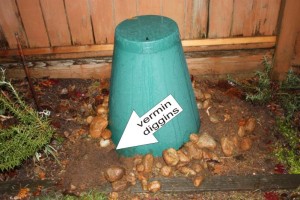It seems the City of New Westminster has decided to move towards single-stream recycling. This means that we will no longer be separating our paper from our plastics and containers, and will be throwing it all into one bin. The bin will be exactly like our existing black (garbage) and green-lid (organics) bins, and will be designed to be picked up by the same trucks.
At the time these ideas were floated, there was little feedback from the public. I didn’t comment at the time, as I felt that I was simply not informed enough to make a useful judgement about the merits of single-stream. I actually had lunch one day with the City’s Supervisor of Solid Waste, hoping he could explain the costs and benefits of going that way. It was clear to me after that meeting that I still didn’t fully understood the issue.
I was present at City Council on April 4 of this year when Allen Lynch , a New Westminster resident and Manager of North Shore Recylcing Program pleaded with council to not go down that path, but to consider the longer-term cost and sustainability implications of Single Stream Recycling. At the time, his issues seemed real, and I was happy to hear council direct Staff to address these concerns (most of which admittedly went over my head). I was equally happy to read a report from staff a month later that seemed to address all of the issues raised by Mr. Lynch. But it still stuck in my craw that somebody with a lifetime of professional experience managing recyclables was so convinced that the City was taking a wrong path going to single stream, and the main benefits to it were explained to me as saving money on trucks. When I feel underinformed, I tend to rely on experts in the field to explain the situation, and for the fourth time in this post already, I will admit I was not well-informed enough to take a position.
There was also quite a bit of discussion with the TrashTalkers group at NWEP, with some seeing the benefit of increased diversion promised by the Single Stream, and loving the idea of going to fortnight waste collection once it comes in, while others lamented the loss of 20 years of effective Community Based Social Marketing around the use of Blue Bins – we have taught a generation to separate recyclables, and recognize the differences in materials, are we going to lose some of that? Again, there were enough sides to this issue that the TrashTalkers could not come up with a consensus opinion, and therefore stayed out of the public debate.
I realise now that was a mistake. I should have met with Helen Spiegelman.
Tuesday, I attended a meeting of Zero Waste Vancouver, where Louise Swartz of Recycling Alternatives and Helen talked about single stream recycling, and the future of Extended Product Responsibility (EPR) programs in BC. It was a too-short 90 minutes, with a lively discussion amongst the participants, and I walked away with much of the information I was so lacking during my earlier ruminations on Single Stream Recycling.
Not to bury the lead; neither Helen (who has been involved in recycling and EPR programs since they began in the 80’s) nor Louise (who runs a very successful small business collecting recyclables from businesses and institutions) think that the move to single stream a good idea, for numerous good reasons.
Let’s see if I can summarise.
The justifications for going to commingling can be broken down to three “C”s: Cost, Convenience, and Capture. You can find them all mentioned here.
Cost is usually up front, and seems to be the main motivation behind New Westminster’s shift. By commingling recyclables, the same truck can be used for recycling as is used for trash, they just hose it out between loads. Therefore fewer vehicles are needed , and fewer crews to run the vehicles. The crews never leave the truck, so you only need one person per vehicle, and no-one is out in the rain physically tossing the recyclables. There is, of course, an upfront cost to buy the bins and the upgrade the trucks ($1.3 million in the case of New Westminster) , and there will actually be a small increase in the fee charged to residents (to cover the cost of the carts), but the City will save money in the long run, if all the other assumptions in the projection hold up.
“Convenience” is the assumption that separating your recyclables is a big hassle. I guess it is hard to argue that tossing everything in one bin is more convenient for the homeowner (… ugh….)
“Capture” is related to this. The assumption is that by making recycling more “convenient”, people will do it more, so a higher percentage of the recyclables will be captured, and diversion rates (the stuff at your curb that doesn’t go to the landfill) will go up. This has been measured in places that have gone to single-stream, and there is usually a slight increase in the percentage of materials going into the blue bins compared to the black bin (in the order of 5-10%).
Now let’s look at the alternative view on these three points:
The Cost savings are amortized over 20+ years, and are based on a lot of assumptions about fuel costs, about how we as a society are going to manage our waste, about where tipping fees are going, and about the future of recycling technology, markets for recycled materials, and producer extended product responsibility (EPR) programs. This is without even getting into the sustainability arguments around externalized costs relating to the down-cycling of materials and the loss of valuable materials, but let’s save that for another day, as this is already too long a rant.
The convenience gains are frankly ridiculous in New Westminster. Currently, the City asks that you separate your “garbage” (black bin) from your organics (green bin) and your recyclable containers and paper (blue box). We further ask that you separate your clean paper and newsprint from your containers by putting it in a blue or yellow bag along with your blue box. With commingling, you will still need to separate your “garbage” from you organics, and put your recyclable containers and paper in a blue bin. The only difference is that you can toss your paper in with the containers without having to put them in the bag first: hardly a massive time saver, and hardly a saving of hours of careful thought as people look at an object and wonder if it is a newspaper or a plastic container. So the increased convenience is a marginal gain at best.
However, what we lose by gaining this convenience is huge: and this is where the big lie comes in. Theoretically, there is an increase in “capture”; people will recycle more due to a mostly imaginary increase in convenience. However, this gain at the curb is very quickly lost at the Material Recovery Plant (MRF), and now we enter the murky world of Residuals.
Your recycled materials, either out of your blue box (plastic, metal and glass) or your new commingled blue bin (plastic metal glass and papers) go to an MRF to be sorted. (if you paper went in a blue/yellow bag, it is alreadt separared, so it goes through a separate process). At the MRF, the metal is removed using magnets and/or density-sorters, and the plastic and paper are sorted partially be mechanical means, and partially by hand. I wrote last year about touring one of these facilities in Iowa, but our MRF is in Surrey. Your recyclables are separated and bundled for shipping off to wherever they will be reprocessed (which is another whole separate Blog topic). At least most of it does. Some of the material that shows up in the MRF is not recyclable, either because it didn’t belong in the recycling in the first place (plastic bags, PVC, wood, BeeGees cassettes, etc.) or because it has been so contaminated and mixed with other materials it cannot be recycled (think a newspaper pressed up against a half-empty yoghurt container in the collection truck compactor). Depending on who you ask, and how you count, the residual rates in the MRFs can range from 5% to 50%. That is a big range. Clearly, even the most modest residual rates will offset any increase in “capture” you got from increased curb-side use. It also does not include the “down-cycling” component, that is the material that comes out of the MRF as much lower quality than it went into the blue bin, and consequently, cannot be used again for its original purpose.
The worst part is this residual rate going up (the 50% end oft he range as opposed to the 5% end) is largly the result of mixing fibre materials with containers, which is the only result of the New Wesmtinster’s commingling initiative! Of the materials being collected for recycling, paper is the one material that is at highest risk of being contaminated by other materials, and it is the material whose value as a commodity in the recycling market is most closely tied to its quality. A few shards of glass or a single sheet of soft plastic can turn a Tonne of paper fibre into a liability for the receiver, and can be stripped of its entire value. This is why the City currently asks you to separate your paper from the other products in the Blue box.
But it gets worse. I don’t know if anyone noticed, but Allen Lynch was quick to point this out at New West Council. As of May, 2011, The Province of BC added “packaging and printed paper” to their EPR regulation. That means that all packaging materials and all printed paper will be managed through an industry-led extended product stewardship program, the same type of program that now makes the producer responsible for refillable bottles, cans, tires, computers, paint, and all those other things you can take to a recycling facility and dispose of at no cost to you (because you paid for the recycling when you bought the product). What does this mean for the commingled recycling? Will the City get paid to collect the paper? Will the city send a bill to the EPR program operator (Encorp, or whomever)? Will all packaging (recyclable plastic and non-recyclable plastic, including films and blister packs) be mixed in with the paper? If so, how will we separate them? Simply put, the answers to these questions arw not known yet. The main point Allen Lynch was trying to make in April was that it may be irresponsible to throw a lot of money down this path until we know where it is going!
OK, one more point, just to throw gas on this fire. What happens to these MRF residuals? Traditionally, they go to the landfill, like the rest of your black bin trash, or potentially into the new incinerators that the region wants to install. However, with increased diversion, with an EPR program on packaging and paper, with organics in the Green Bin, there will continue to be less and less black bin trash. The fuel source for these incinerators is going away, even before they are built. However, residual waste from the MRF is excellent incinerator fuel! With the organics and wet materials out of it, it is low moisture, with the metal sorted out at the MRF, you are left with paper mixed with plastic film, heavy plastic, and a bit of broken glass: this shit will burn great! This I where the cynic says: The entire commingling move is a back-door way of diverting otherwise-recyclable materials to incinerators!
People who know me know I am not a conspiracy theorist, I always default to Hanlon’s razor. However, the implications of commingling are both unclear (in the real costing and in the fact that the metrics for diversion vs. residuals are very muddy from any City that has gone that way), and crystal clear (what the fate of the materials you put in your blue bin will be). The case for commingling is so poorly made, that I am waiting to be convinced that there is a sustainability component that I am missing. And while I wait, we are spending millions buying trucks and building incinerators.
I will come back to this theme in later posts. Mostly, I am confused about what we do next to deal with this issue. In New Westminster, we will be moving to commingling in 2012 unless we can prove to the Council prior to the November election that this is not the way we want to manage our recyclables. It is also an open secret that our Mayor is very interested in having a garbage incinerator installed in our City, in spite of the loud and ongoing public opposition to the idea.
To be continued…
